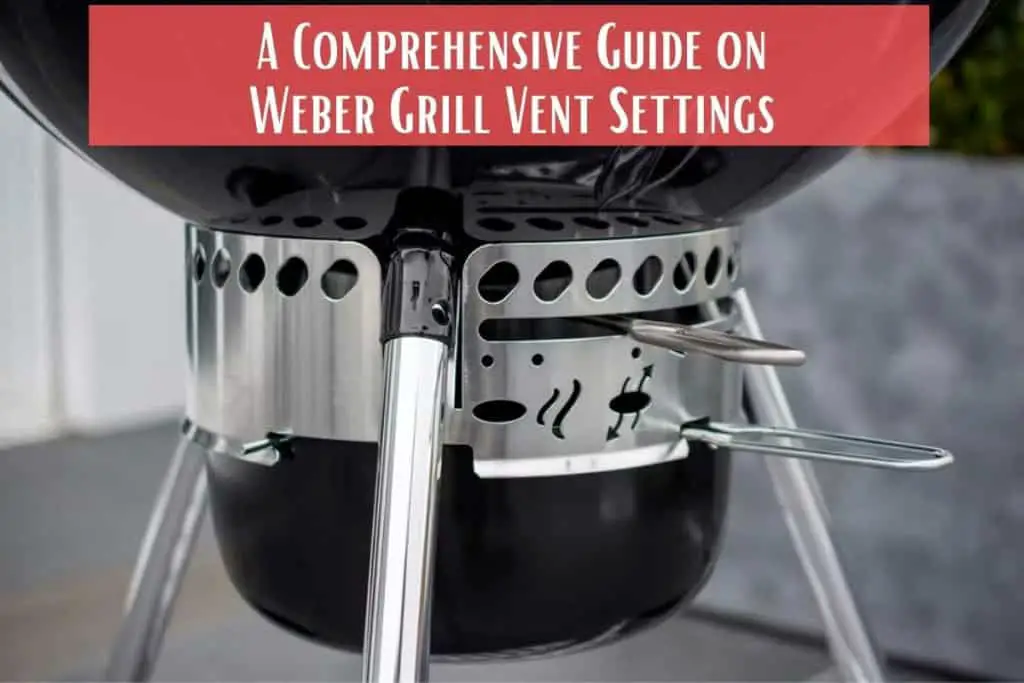I’m often flooded with questions regarding all aspects of grilling, but one of the interesting ones I’ve come across lately is what are Weber grill vents, more specifically what are the best Weber grill vent settings.

Well, the answer to these questions is a bit complex, but I’ve crafted a comprehensive guide on Weber grill vent settings. So, without further ado, let’s dive right in!
What are Grill Vents?
There are myriad factors that contribute to a great grilling experience, of which temperature control is the most important and also one of the most challenging.
Your charcoal grill is essentially powered by two things—the coals sitting at the bottom of the cook box (fuel) and the oxygen flowing through it. Therefore, it’s important to control both types of fuel for successful grilling.
Grill vents, also called dampers are basically porta that are designed to feed oxygen into your grill.
These dampers aren’t to be mistaken for chimneys or exhausts that come with certain charcoal grill models but instead allow you to directly control the temperature inside the grill.
Before moving further, I should mention that grill vents only apply to charcoal grills, because gas grills feature built-in controls to help with temperature control and fuel supply.
The wider the vents are open, the more oxygen input into the grill, resulting in more heat in the cooking chamber.
When the vents are closed, the supply of oxygen is cut off, hence less heat flows into the chamber.
Weber Charcoal Grill Vent Settings
For various temperature ranges
High heat (450-550°F) – Fully open
Medium heat (350-450°F) – ½ open
Low heat (250-350°F) – ¼ open
Low and slow/smoke zone (225-275°F) – 1/4 – 1/8 open
Off – Fully closed
Where are the Vents Located on a Weber Charcoal Grill?
That depends on the model, but the vents on most weber charcoal grills are located at the bottom.
Some Weber charcoal grill models feature events at both the top and bottom, where the former is called exhaust dampers that are designed to take the smoke away, and the latter are known as intake dampers that provide airflow to the coals.
How to Use the Vents on a Weber Grill?
Many new and even avid grillers believe that the more charcoal used, the more heat generated inside the grill, but this isn’t the case.
As I mentioned earlier, most Weber grills come with two dampers—the vents on the bottom bowl, and a top lid damper.
Weber recommends opening the bottom dampers completely, and controlling the temperature via the top lid damper.
However, there are several other factors that can affect the temperature inside your charcoal grill such as the temperature outside, wind conditions, how clean your grill, and even the type of food you’re grilling.
How do the Vents on a Weber Grill Work?
The way Weber grill vents work boils down to three stages, so here’s the lowdown. The first stage applies to when you start your grill, and at this time you should open the grill vents completely to let oxygen in while keeping the lid shut.
After your grill is fired up, you will have to lower the temperature inside the chamber, but you also don’t want to cut the supply of oxygen to the charcoal.
You can do this by closing the vents either halfway or three-quarters of the way shut. Keeping the grill vents at this position will limit the flow of oxygen without starving the coals of oxygen completely.
Adding to this, this vent position will also help you achieve the right temperature needed for proper meat cooking—225°F. If the inside of your grill is getting too smoky, open up the vents a little more.
The last stage is when you want to fully extinguish the flames after you’re done grilling, which you can do by closing the vents completely.
To summarize how the airflow of a Weber grill works:
- The vents at the bottom of your grill let in oxygen that’s present outside the grill.
- The oxygen fuels the charcoal, which allows the coals to produce flames.
- These flames are responsible for generating heat and smoke inside the grill.
- The vents located at the top of the grill remove smoke and excess heat from the chamber of your charcoal grill, which consequently pumps more fresh air and oxygen into the grill.
- Air cannot enter when the grill vents are closed, which means that the charcoal won’t burn, and the flames will die out.
- If you want a higher temperature, open the vents to let more air in, and for a lower temperature close the vents partially.
Is Weber Hotter with Vents Open or Closed
If you close the vents to your Weber grill, you will deprive the charcoal of oxygen, therefore the fire will go out.
For a hotter grill and a higher heat temperature, the vents of your Weber grill should always be open.
Ideally, the vents of your Weber grill should only be closed completely when trying to put out the fire.
Weber Bottom Vent Open or Closed
The bottom vent of your Weber grill should always be open, you want to close them partially if you want to lower the temperature. If you’re experiencing flare-ups, close the top dampers partially.
Final Thoughts
Controlling the temperature inside your Weber charcoal grill is a matter of mastering how to use the grill vents.
Apart from opening and closing the when you start the grill, during the grilling session, and when trying to put out the fire, you should always keep the ash catcher clean to avoid hindering the airflow inside the grill.
If your Weber grill didn’t come with a grill thermometer, you can but a good model at an affordable price to keep tabs on the overall ambient temperature of the grill.
There are also several must-have products to have with a charcoal grill including lighter cubes, and a chimney starter.


